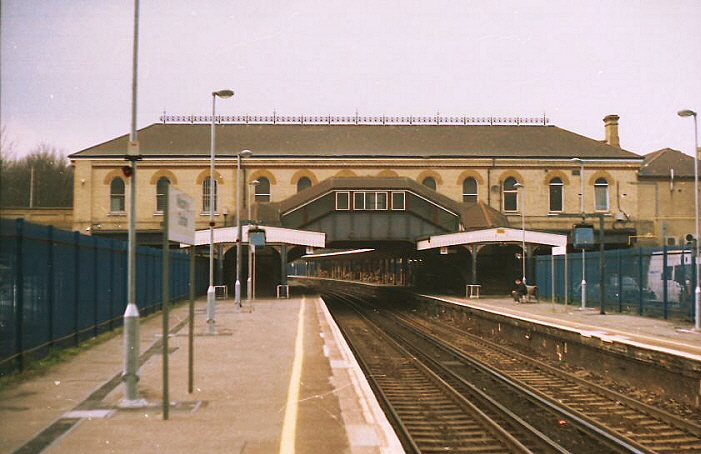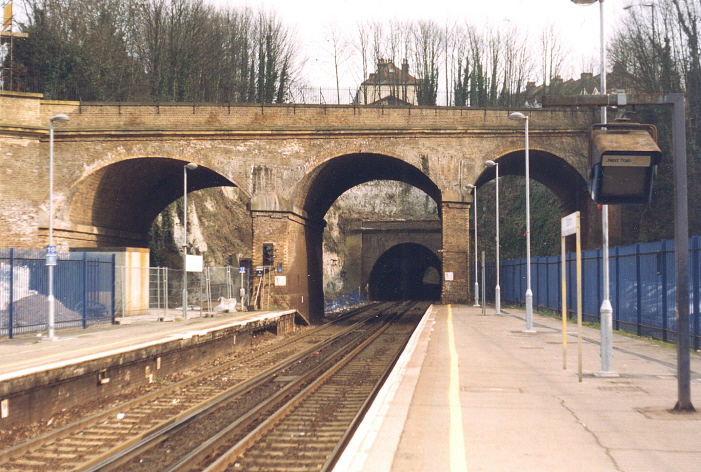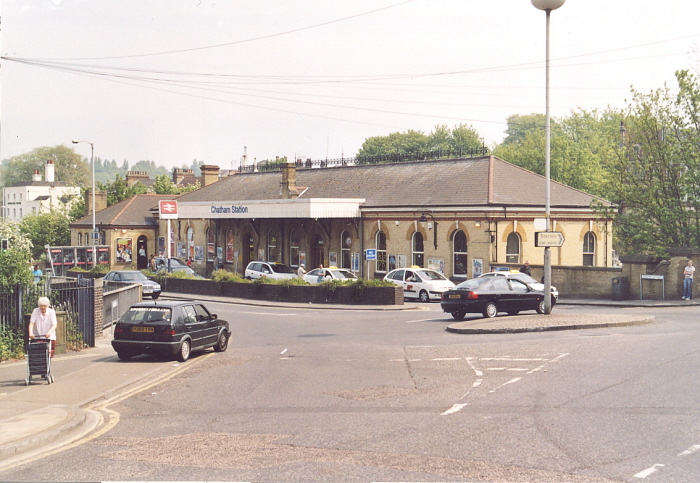
Existing as a then recent modernisation of the LC&DR, Chatham changed little under SE&CR auspices. It was under the Southern Railway that considerable service improvement occurred, in addition to infrastructure alterations at the station. The SR quickly embarked on the electrification of ex-SE&CR suburban lines – electric working to Orpington from Holborn Viaduct and Victoria commenced as early as 12th July 1925. The extension of third rail to the Medway Towns formed the final part of the SR’s Eastern Section electrification, and the outer limit of suburban electric operation became Gillingham. Electric working to this outpost began on 2nd July 1939, coinciding with the extension of third rail operation to both Maidstone stations. The turntable at Chatham was removed as a consequence, but a 50-foot example remained at Gillingham for rotating locomotives. Electric lighting came into use on the platforms, and this appears to have been supported upon a mixture of wrought iron and concrete bracket lampposts. Where stations lacked a conventional mains electricity supply, the lighting system was connected directly to the live third rail. The wrought iron lampposts were most likely of LC&DR origin, but with modified SR heads, installed during the previous decade. Attached to the posts were the SR’s familiar ‘’Target’’ name signs. All tracks of the layout received third rail – even the short dock line, which could accommodate at maximum a standard carriage length, and certainly not a multiple unit formation. The entire electrification scheme had been preceded six years earlier by the closure of the Saxby & Farmer signal box at the ‘’country’’ end of the layout, this going out of use on 26th February 1933.
During World War II, the ‘’high level’’ station building lost the attractive ironwork along the top of its roof. The subsequent British Railways era was also to be one of severe rationalisation of the layout. Modernisation began with the commissioning of colour light signals at the London end of the layout, these replacing semaphore signals on 16th May 1954. The existing Saxby & Farmer cabin at the London end of the layout remained in operation, and became interlocked with the revised colour light arrangement. In February 1956, the Kent Coast Electrification Scheme was given the green light, which promised the elimination of steam-hauled services on the South Eastern Division, and quicker journey times. In Spring 1959, work began on reducing Chatham’s five platform faces down to a mere two. The station’s location deep within a chalk cutting saw that the two island platform surfaces were extended at their London ends right up to the tunnel portal, using prefabricated concrete. As a result, the outer faces of each island, and all sidings, were taken out of use, since the tracks became physically disconnected from the two running lines at the entrance to Fort Pitt Tunnel. At the ‘’country’’ end of the layout, the presence of a road bridge prevented platform extensions being taken up to the portal of Chatham Tunnel. This allowed a truncated section of the line which was served on either side by a platform face, to remain in use for parcels traffic, and this maintained a trailing connection with the ‘’down’’ running line. Mechanical signalling at Chatham had its swansong on 9th May 1959, when the Saxby & Farmer cabin was decommissioned after over seventy years of service. New signalling came into use the following day, comprising three-aspect colour lights controlled from a then new ‘’power box’’ at Rochester.
The ‘’down’’ island canopy was truncated by a severe 145-foot at its ‘’country’’ end, and the equivalent part of the ''up'' island canopy was cut back by 60-foot – on the London side of the ‘’high-level’’ entrance, all existing platform structures were completely swept away. The London end of the ‘’up’’ platform became host to a 200-foot-long upward-sloping canopy, fabricated of steel and glass, and built to the same clinical design as those which emerged at St Mary Cray and Dover Marine stations. A single-storey yellow-brick 160-foot-long block, accommodating waiting rooms and offices, emerged behind the sole remaining ‘’up’’ platform face. The ‘’down’’ side received a much longer V-shaped canopy at its London end, this extending for 295-feet and incorporating 120-foot-long office accommodation along its rear elevation.
The new buildings were completed in Spring 1961, but at least Chatham had managed to retain its attractive ''high-level'' station building, and those canopies to the east of the road bridge. The last scheduled steam-hauled service along the route had previously run on 14th June 1959, the full accelerated electric timetable to Dover and Thanet via Faversham coming into use the following day. The transformation of Chatham was now complete – no longer was the station capable of handling military traffic or bananas of Elders & Fyffes Shipping Limited.
With thanks to Peter Greenhow for indicating the retention of single-track spur after 1959.

The station building has been spruced up, and the ornamental ironwork has returned to the structure's roof. Only 25-foot of the 1886-designed canopy remains on the ''up'' (left-hand side) platform; that on the ''down'' side is even shorter, at 20-feet. Beyond the station building, all platform structures are of 1961 origin. The blue palisade fencing on both sides of the station marks the platform faces which went out of use to passengers in 1959: the areas beyond, on either side, have been converted into the now customary car parks. © David Glasspool

The three-arch viaduct to the east of the platforms carries ''Maidstone Road'', whilst beyond it is Chatham Tunnel, some 297 yards in length. The first viaduct arch from the left once gave access to the turntable spur, whilst a water column formerly occupied a small area at the end of the ''down'' platform. The sheer chalk cliffs shown here explain why it has never been possible to substantially expand the station in any direction. © David Glasspool

The main building of 1886 is seen on 13th May 2006, and is evidently in much better condition than its later 1894 counterpart at Bickley. The example at Bromley South was mostly rebuilt for the Kent Coast Electrification Scheme. On the far left can be seen the two-storey high appendix, which extends down to platform level. The arched orange window frames are a typical LC&DR feature. © David Glasspool

This westward view is of interest, for it shows the extent of the pre-1959 station layout. The ''down'' (right) platform has lost at least a third of its useable surface, as a result of palisade fencing, after the lifting of the one remaining siding. The gaps underneath the station building, where additional lines formerly laid, are obvious. © David Glasspool
Return to the Kent Rail Homepage or alternatively, check for Updates.
Website & Copyright information - Links - Contact the Webmaster